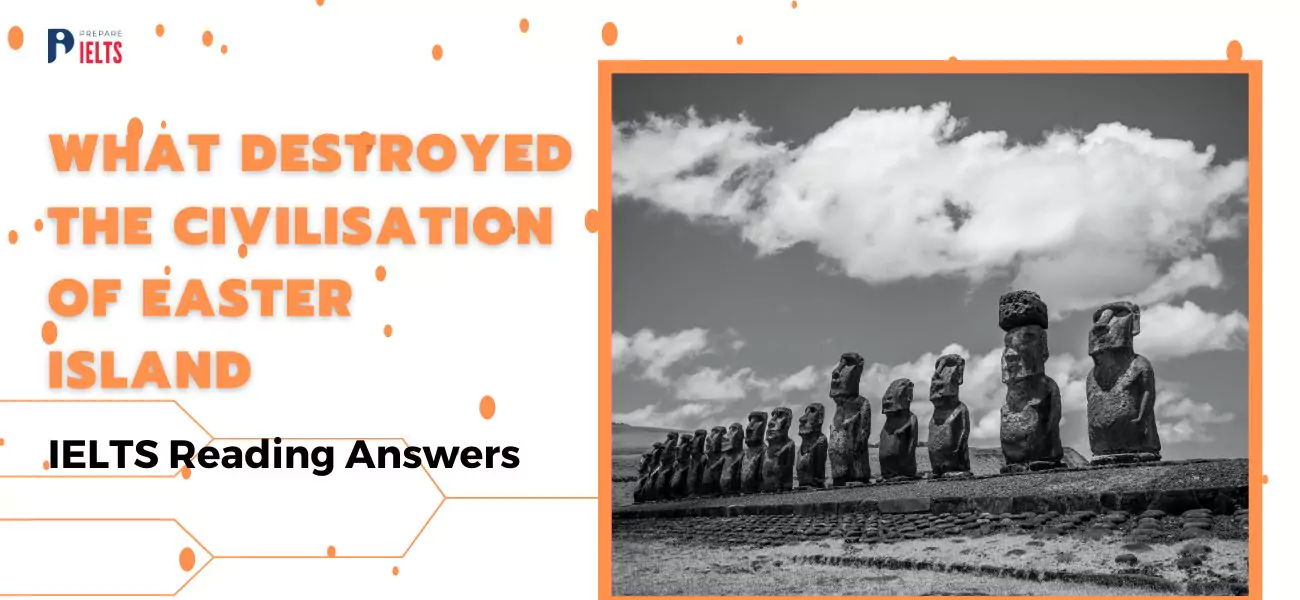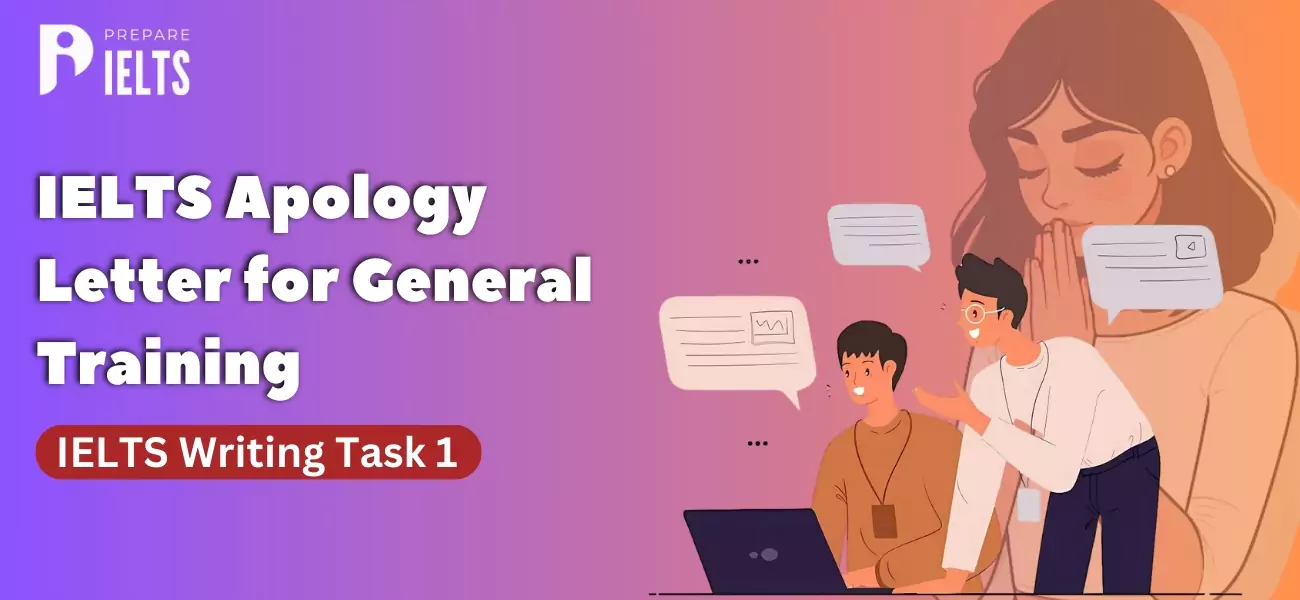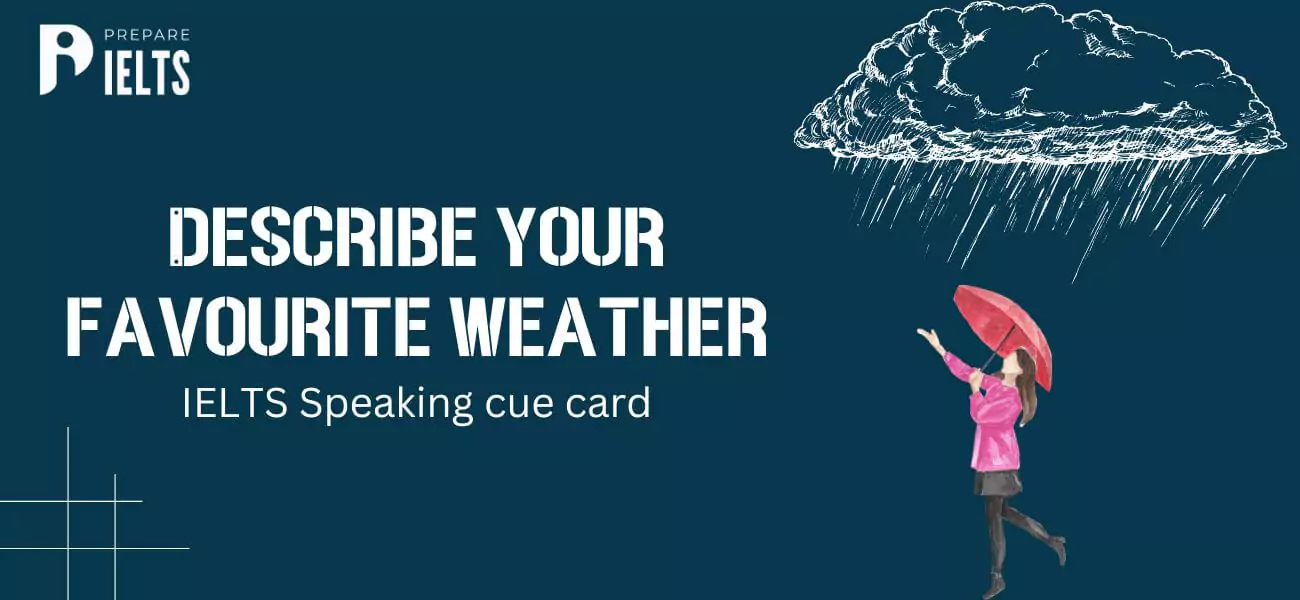
Overview
Many students struggle to obtain answers and clear explanations for the IELTS reading passage 2 questions. However, in order to effectively prepare for the test, it is critical to analyse and understand the reasoning behind each correct response. As a result, in this blog, we have included the best solutions with clear and simple explanations of the topic "What destroyed the civilisation of Easter Island?" So, let's start with the blog!
What destroyed the civilisation of easter island - IELTS Reading Passage
-
Easter Island, or Rapu Nui as it is known locally, is home to several hundred ancient human statues - the moai. After this remote Pacific island was settled by the Polynesians, it remained isolated for centuries. All the energy and resources that went into the moai - some of which are ten metres tall and weigh over 7,000 kilos - came from the island itself. Yet when Dutch explorers landed in 1722, they met a Stone Age culture. The moai were carved with stone tools, then transported for many kilometres, without the use of animals or wheels, to massive stone platforms. The identity of the moai builders was in doubt until well into the twentieth century. Thor Heyerdahl, the Norwegian ethnographer and adventurer, thought the statues had been created by pre-Inca peoples from Peru. Bestselling Swiss author Erich von Daniken believed they were built by stranded extraterrestrials. Modern science - linguistic, archaeological and genetic evidence - has definitively proved the moai builders were Polynesians, but not how they moved their creations. Local folklore maintains that the statues walked, while researchers have tended to assume the ancestors dragged the statues somehow, using ropes and logs.
-
When the Europeans arrived, Rapa Nui was grassland, with only a few scrawny trees. In the 1970s and 1980s, though, researchers found pollen preserved in lake sediments, which proved the island had been covered in lush palm forests for thousands of years. Only after the Polynesians arrived did those forests disappear. US scientist Jared Diamond believes that the Rapanui people - descendants of Polynesian settlers - wrecked their own environment. They had unfortunately settled on an extremely fragile island - dry, cool, and too remote to be properly fertilised by windblown volcanic ash. When the islanders cleared the forests for firewood and farming, the forests didn’t grow back. As trees became scarce and they could no longer construct wooden canoes for fishing, they ate birds. Soil erosion decreased their crop yields. Before Europeans arrived, the Rapanui had descended into civil war and cannibalism, he maintains. The collapse of their isolated civilisation, Diamond writes, is a ’worst-case scenario for what may lie ahead of us in our own future’.
-
The moai, he thinks, accelerated the self-destruction. Diamond interprets them as power displays by rival chieftains who, trapped on a remote little island, lacked other ways of asserting their dominance. They competed by building ever bigger figures. Diamond thinks they laid the moai on wooden sledges, hauled over log rails, but that required both a lot of wood and a lot of people. To feed the people, even more land had to be cleared. When the wood was gone and civil war began, the islanders began toppling the moai. By the nineteenth century none were standing.
-
Archaeologists Terry Hunt of the University of Hawaii and Carl Lipo of California State University agree that Easter Island lost its lush forests and that it was an ‘ecological catastrophe' - but they believe the islanders themselves weren’t to blame. And the moai certainly weren’t. Archaeological excavations indicate that the Rapanui went to heroic efforts to protect the resources of their wind-lashed, infertile fields. They built thousands of circular stone windbreaks and gardened inside them, and used broken volcanic rocks to keep the soil moist. In short, Hunt and Lipo argue, the prehistoric Rapanui were pioneers of sustainable farming.
-
Hunt and Lipo contend that moai-building was an activity that helped keep the peace between islanders. They also believe that moving the moai required few people and no wood, because they were walked upright. On that issue, Hunt and Lipo say, archaeological evidence backs up Rapanui folklore. Recent experiments indicate that as few as 18 people could, with three strong ropes and a bit of practice, easily manoeuvre a 1,000 kg moai replica a few hundred metres. The figures’ fat bellies tilted them forward, and a D-shaped base allowed handlers to roll and rock them side to side.
-
Moreover, Hunt and Lipo are convinced that the settlers were not wholly responsible for the loss of the island’s trees. Archaeological finds of nuts from the extinct Easter Island palm show tiny grooves, made by the teeth of Polynesian rats. The rats arrived along with the settlers, and in just a few years, Hunt and Lipo calculate, they would have overrun the island. They would have prevented the reseeding of the slow-growing palm trees and thereby doomed Rapa Nui’s forest, even without the settlers’ campaign of deforestation. No doubt the rats ate birds’ eggs too. Hunt and Lipo also see no evidence that Rapanui civilisation collapsed when the palm forest did. They think its population grew rapidly and then remained more or less stable until the arrival of the Europeans, who introduced deadly diseases to which islanders had no immunity. Then in the nineteenth century slave traders decimated the population, which shrivelled to 111 people by 1877.
-
Hunt and Lipo’s vision, therefore, is one of an island populated by peaceful and ingenious moai builders and careful stewards of the land, rather than by reckless destroyers ruining their own environment and society. ‘Rather than a case of abject failure, Rapu Nui is an unlikely story of success’, they claim. Whichever is the case, there are surely some valuable lessons which the world at large can learn from the story of Rapa Nui.
Also read: The Step Pyramid of Djoser - IELTS Reading Answers
What destroyed the civilisation of easter island - Questions and Answers
Questions 1-7:
The Reading Passage has seven paragraphs, A-G.
Choose the correct heading for each paragraph from the list of headings below.
Write the correct number, i-ix, in boxes 1-7 on your answer sheet.
List of Headings
i. Evidence of innovative environment management practices
ii. An undisputed answer to a question about the moai
iii. The future of the Moai statues
iv. A theory which supports a local belief
v. The future of Easter Island
vi. Two opposing views about the Rapanui people
vii. Destruction outside the inhabitants’ control
viii. How the statues made a situation worse,
ix. Diminishing food resources
Answer 1: ii) An undisputed answer to a question about the moai
Explanation 1: The 1st paragraph, 6th sentence, has included a few significant moai-related information. According to the author, it has been established via linguistic, archaeological, and genetic evidence that Polynesians were the people who built the moai. Thus, "An uncontested response to a query regarding the moai" is an appropriate heading for the same.
Answer 2: ix) Diminishing food resources
Explanation 2: The 6th and 7th lines of paragraph 2 claim that the islanders cleared the trees for cultivation and firewood. Because of this, the trees are getting less and are unable to make wooden fishing boats. As a result, the availability of food is steadily declining. Consequently, the headline "Diminishing food resources" accurately summarises what is said in the text.
Answer 3: viii) How the statues made a situation worse
Explanation 3: From the 3rd paragraph, first sentence, the author provides evidence to support the claim that Moai has accelerated its own demise. He gave a rundown of everything that happened in that time frame. In order to compete, they would construct larger figures, place the moai on wooden sledges, and clear more ground. Thus, it illustrates how those monuments have made things worse.
Answer 4: i) Evidence of innovative environment management practices
Explanation 4: The 2nd last line of paragraph 4 describes Rapanui's creative methods for safeguarding the resources in their barren, wind-blown land. They develop a garden inside and build multiple circular stone windbreaks, using shattered volcanic rocks to keep the soil fresh. Consequently, it is thought that the title "Evidence of innovative environment management practices" is the best fit for the paragraph.
Answer 5: iv) A theory which supports a local belief
Explanation 5: In the 3rd sentence of the 5th paragraph, It is mentioned that Hunt and Lipo have provided archaeological proof to support the notion held by the locals. They claimed that just a handful of persons could move a 1,000-kilogram duplicate of the Moai more than a few hundred meters with ease. The figures were inclined forward by their fat stomachs, and operators could roll and rock them side to side thanks to a D-shaped base. As such, it upholds the regional religion.
Answer 6: vii) Destruction outside the inhabitants’ control
Explanation 6: The paragraph 6th illustrates the island's trees' suffering. According to Hunt and Lipo's analysis, the rats infiltrated the island's trees after coming there with the residents. Because there were no hygienic crops, the islanders were immune deficient and frequently fell ill with fatal illnesses. As a result, the paragraph's context is satisfied by the title "Destruction outside the inhabitants' control."
Answer 7: vi) Two opposing views about the Rapanui people
Explanation 7: In the 1st and 2nd sentences of paragraph 7, the author has presented two different perspectives on Rapanui. On the one hand, Hunt and Lipo have contributed to the idea that the people who built the moai were creative and calm. However, another viewpoint stated that the Rapanui were thoughtless destructors who were destroying their own environment and society. Therefore, it would appear that the heading "Two opposing views about the Rapanui people" is appropriate for this paragraph.
Also Check: IELTS One Skill Retake- Retaking IELTS Exam 2024
Questions 8-11:
Complete the summary below.
Choose ONE WORD ONLY from the passage for each answer.
Write your answers to questions 8-11 in boxes 21-24 on your answer sheet.
Jared Diamond’s View
Diamond believes that the Polynesian settlers on Rapa Nui destroyed its forests, cutting down its trees for fuel and clearing land for 21 .................... Twentieth-century discoveries of pollen prove that Rapu Nui had once been covered in palm forests, which had turned into grassland by the time the Europeans arrived on the island. When the islanders were no longer able to build the 22 .................... they needed to go fishing, they began using the island’s 23 .................... as a food source, according to Diamond. Diamond also claims that the moai were built to show the power of the island’s chieftains, and that the methods of transporting the statues needed not only a great number of people, but also a great deal of 24 .................... .
Answer 8: farming
Explanation 8: The 6th sentence of the 2nd paragraph makes Jared Diamond's point of view that Polynesian settlers are destroying the forests clearly apparent. They are chopping down trees for fuel and clearing forest land for cultivation. For this reason, "farming" is the appropriate response to the missing word.
Answer 9: canoes
Explanation 9: In the 2nd paragraph, 6th line, According to Jared Diamond, the islanders removed the forest to cultivate and make firewood. There becomes a shortage of wood when forests are removed, and it doesn't grow again. They were unable to build the wooden canoes needed for fishing. Therefore, "canoes" is the right response.
Answer 10: birds
Explanation 10: According to the 2nd paragraph, 6th line, the islanders removed the forest for farming and firewood, according to Jared Diamond. There becomes a shortage of wood when forests are removed, and it doesn't grow again. They were unable to build the wooden canoes needed for fishing. Food is now scarce as a result of agricultural yields declining due to soil erosion. They began consuming birds. Thus, "birds" is the right response.
Answer 11: wood
Explanation 11: According to the 3rd sentence of the 3rd paragraph, As to Diamond's perspective, the islanders used log rails to pull the moai over them after laying it on wooden sledges. He clarified that a large number of people and wood were needed for this. Therefore, "wood" is the appropriate response to complete the blank.
Also Check: What is the IELTS Vocabulary?
Questions 12 and 13:
Choose TWO letters, A-E.
Write the correct letters in boxes 25 and 26 on your answer sheet.
On what points do Hunt and Lipo disagree with Diamond?
-
the period when the moai were created
-
how the moai were transported
-
the impact of the moai on Rapanui society
-
how the moai were carved
-
the origins of the people who made the moai
Answer 12: B
Explanation 12: In the 1st sentence of the 5th paragraph, it is mentioned that Diamond believes a lot of wood is needed to move the moai. It is also said that the islanders started to topple the moai during the civil war. Nonetheless, Hunt and Lipo have presented archaeological data to explain the moai's transportation process. It requires very little labour and no wood. They claimed that just a handful of persons could move a 1,000-kilogram duplicate of the Moai more than a few hundred meters with ease. The figures were inclined forward by their fat stomachs, and operators could roll and rock them side to side thanks to a D-shaped base.
Answer 13: C
Explanation 13: According to Diamonds, in paragraph C, 1st paragraph, the moai hastened the island's devastation. Still, Hunt and Lipo were persuaded enough that the island's destruction was not entirely the result of its residents. It is abundantly evident that these two groups do not agree on how moai has affected Rapa Nui society.
Also read: William Henry Perkin - IELTS Reading Answers
Register Now, for a free Mock test - Join Today!
Conclusion
Overall, you can choose the right answer to the questions by carefully reading the paragraph and focusing on the meaning of the words and sentences. Students are urged to rapidly review the questions once before reading the passage.
If you want to get further details on how to prepare for IELTS or, particularly, the IELTS Reading section, you can contact the Prepare IELTS exam (PI) expert counsellors for additional guidance. Our team of education experts is dedicated to providing you with the best test material and guidance to ace the IELTS exam. You can get a one-on-one counselling session and an IELTS online practice test via our platform. Contact us at info@prepareieltsexam.com or call us at +91 9773398388 for further queries.
Latest Blogs
-

IELTS Score for Canada: Minimum IELTS Requirement for Canada 2025
2024-09-27 18:24:14
-

IELTS Apology Letter for General Training: IELTS Writing Task 1
2024-09-25 16:38:03
-

Minimum IELTS Score for Australia: Student Visas, Universities, and PR in Australia
2024-09-23 18:09:51
-

Common IELTS Speaking Topics with Answers
2024-09-20 18:21:56
-

Describe a foreign culture that you like: IELTS speaking cue card
2024-09-18 16:14:11
-

Describe a Rainy Day IELTS Speaking cue card
2024-09-18 11:11:32
-

Describe a new law you would like to introduce in your country IELTS cue card
2024-09-13 17:17:46
-

Describe your favourite weather: IELTS cue card
2024-09-11 18:01:28
-

Describe an enjoyable journey by public transport: IELTS cue card
2024-09-09 18:05:45
-

Step-by-Step Guide to IELTS Registration in India for the Year 2024 & 2025
2024-09-07 12:59:51


